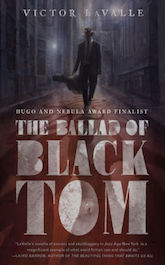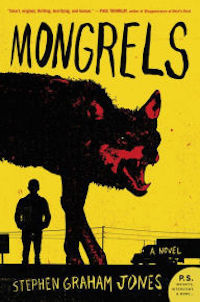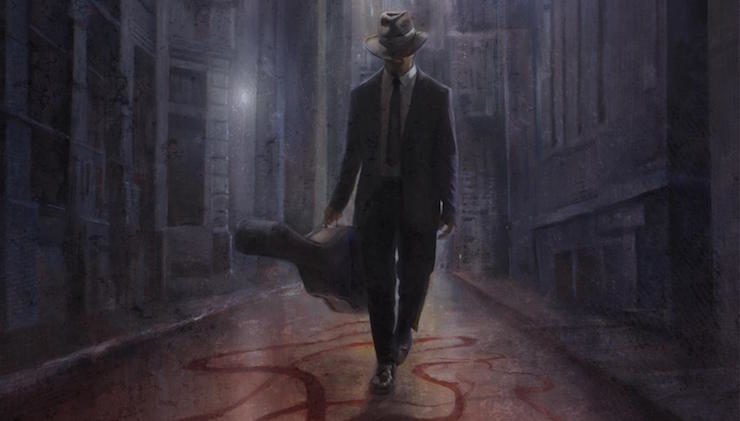“The smell coming off her was all about change.”
–Stephen Graham Jones, Mongrels, 2016
When teaching the Literature of Science Fiction at CSU Long Beach, one of the key texts I often assign is At the Mountains of Madness by H.P. Lovecraft, a short novel originally published in 1936 that points the way toward the blurring of genre boundaries so prevalent in the work of the most memorable fabulists of the past few decades, Steve Aylett, Steve Erickson, Jonathan Lethem, Thomas Pynchon, and Jack Womack foremost among them.
The students’ reaction to Lovecraft is often split down the middle; there are those who adore Lovecraft’s work and those who revile it. One student believed that, due to Lovecraft’s documented racism, no one should be allowed to read his work. Her fear, apparently, was that by exposing ourselves to Lovecraft’s fiction, we would in turn be laying ourselves naked to the author’s worst character flaws. It was as if she believed that reading H.P. Lovecraft might lead one to become H.P. Lovecraft, almost as if the supernatural phenomenon of body possession Lovecraft wrote about so often in his fiction (e.g., The Case of Charles Dexter Ward, “The Shadow Out of Time,” “The Thing on the Doorstep,” etc.) was possible in the real world. My syllabus, due to its inclusion of Lovecraft, was somehow putting the students at risk of having their precious bodily fluids spoiled irreversibly by transgressive notions forged way back in the Jazz Age.
Needless to say, this is an odd viewpoint for a student—particularly a Creative Writing major—to hold. If anyone could separate the work from the author, you would think it would be another writer. As a writer myself, I find such a puritanical stance to be completely antithetical to artistic expression. By the second decade of the twenty-first century, it shouldn’t be necessary to invoke the words of George Santayana (“Those who cannot remember the past are condemned to repeat it”), but apparently for some it is necessary. It should be obvious that only by remembering the past and building on it can any form of literature evolve.
Buy the Book


The Ballad of Black Tom
We see this evolutionary process displayed beautifully in two recent works of imaginative literature. Victor LaValle’s metatextual 2016 short novel, The Ballad of Black Tom, is to Lovecraft’s 1927 story “The Horror at Red Hook” what Tom Stoppard’s Rosencrantz and Guildenstern Are Dead is to Shakepeare’s Hamlet. LaValle’s haunting tale of a Harlem musician accidentally swept up in a twilit realm marked by rampant demon worship and unchecked police brutality illuminates the Roaring Twenties in which Lovecraft wrote his original story while also commenting slyly and ruthlessly on the directed acts of violence that seem to overshadow our own world. LaValle’s tale occurs in the previously unexplored margins of “The Horror at Red Hook,” breathing a disturbing form of three-dimensional life into Lovecraft’s pulp characters (particularly Irish police detective Thomas F. Malone) that the original tale never even attempts. Like all great pastiches, The Ballad of Black Tom enables one to revisit Lovecraft’s “The Horror at Red Hook” from a startling new perspective that succeeds in deepening the experience of reading the original. If Lavalle had taken my student’s advice and ignored the lessons that can be learned from immersing oneself in the dark worlds of Lovecraft, The Ballad of Black Tom would never have been written, and the field of weird fiction would be much poorer for it.
In Stephen Graham Jones’ 2016 novel, Mongrels, the werewolf archetype is turned upside down and inside out in so many imaginative and convincing ways that one might wonder if the author was personally acquainted with lycanthropes himself. Clearly, the author has spent a lifetime thinking about werewolves and how such an ancient superstition might relate to the brutal realities of our own world. Like almost all horror archetypes, the werewolf has often been used in the past to create stories that are reactionary at their core. The fear of the Other pervades many of the original werewolf/manbeast tales that emerged from Christian Europe in the Middle Ages, as Dr. Robert Curran points out in his 2009 book, Werewolves. A telling example, taken from American cinema, is Edward Dmytryk’s 1943 Universal horror flick, Captive Wild Woman, in which an African ape named Cheela transmogrifies into a naïve, dark-haired, “exotic” beauty named Paula Dupree (portrayed by Acquanetta). Whenever Paula is overcome with sexual jealousy, her coffee-colored flesh darkens by degrees until she literally metamorphoses into a black woman, “devolves” further into a half-human/half-ape beast that looks exactly like a werewolf, sheds all trace of her “civilized” exterior, then gives in to her inherent, genetically predestined bloodlust.
To underscore the racial subtext further, it’s worth noting that Universal featured Acquanetta in several different B-films during World War II in a desperate attempt to groom her into their next big horror star. Unfortunately, when executives at Universal discovered that Acquanetta’s “exotic” features stemmed not from Venezuela, as her managers claimed, but from the fact that she was African-American, Universal summarily dropped her contract. Acquanetta never starred in another film again, and was forced to abandon Hollywood soon after Universal barred her from the lot due solely to her race. Captive Wild Woman is a prime example of a “werewolf” tale in which the fear of the Other is reflected in both the foreground plot as well as in the background politics that produced the film.
Buy the Book


Stephen Graham Jones is well aware of this dark side of werewolf history and makes use of it throughout Mongrels, in which the protagonist’s outsider status and seemingly endless encounters with distrust, paranoia, and xenophobia fuel the plot far more than the core fantasy element (which might very well have come off as superficial in a lesser novelist’s hands). As the late Theodore Sturgeon often advised, a good writer should always “ask the next question.” Jones is the type of novelist who always “asks the next question.” In Mongrels, he is in complete control of his central metaphor and explores every possible thematic tributary without once glancing away from the disturbing implications. If the werewolf’s connection to past tales of xenophobia had dissuaded Jones from reconfiguring the well-worn archetype into the magical fable that is Mongrels, the literary world would have lost one of the most impressive coming-of-age novels written in the past twenty years.
A legitimate purpose of literature, not unlike the wise alchemists of old, is to appropriate base elements and transmogrify them into dangerous visions for a strange and uncertain new century. Victor LaValle and Stephen Graham Jones have proven themselves as adept at this type of magic as H.P. Lovecraft himself when he transformed the most staid elements of nineteenth century Gothic literature into numerous compelling, influential classics of the phantastique, At the Mountains of Madness a touchstone example. If the literature of science fiction and fantasy has ever been about anything, it’s been about change. Without a comprehensive knowledge of the past, there can be no change—only stasis, paralysis, and eternal stagnation.
Robert Guffey‘s most recent book is Until the Last Dog Dies (Night Shade/Skyhorse), a darkly satirical novel about a young stand-up comedian who must adapt as best he can to an apocalyptic virus that affects only the humor centers of the brain. His previous books include the journalistic memoir Chameleo: A Strange but True Story of Invisible Spies, Heroin Addiction, and Homeland Security (OR Books, 2015), a collection of novellas entitled Spies & Saucers (PS Publishing, 2014), and Cryptoscatology: Conspiracy Theory as Art Form (TrineDay, 2012). His website is Cryptoscatology.com.










